非限制性定语从句教案资料
- 格式:doc
- 大小:56.50 KB
- 文档页数:7
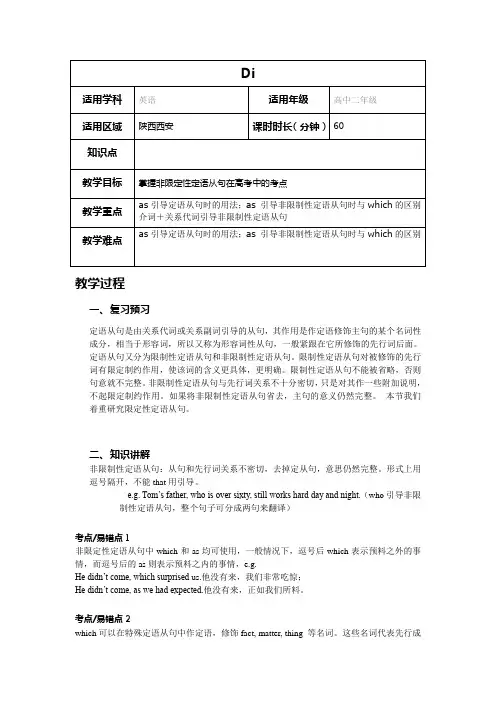
教学过程一、复习预习定语从句是由关系代词或关系副词引导的从句,其作用是作定语修饰主句的某个名词性成分,相当于形容词,所以又称为形容词性从句,一般紧跟在它所修饰的先行词后面。
定语从句又分为限制性定语从句和非限制性定语从句。
限制性定语从句对被修饰的先行词有限定制约作用,使该词的含义更具体,更明确。
限制性定语从句不能被省略,否则句意就不完整。
非限制性定语从句与先行词关系不十分密切,只是对其作一些附加说明,不起限定制约作用。
如果将非限制性定语从句省去,主句的意义仍然完整。
本节我们着重研究限定性定语从句。
二、知识讲解非限制性定语从句:从句和先行词关系不密切,去掉定从句,意思仍然完整。
形式上用逗号隔开,不能that用引导。
e.g. Tom’s father, who is over sixty, still works hard day and night.(who引导非限制性定语从句,整个句子可分成两句来翻译)考点/易错点1非限定性定语从句中which和as均可使用,一般情况下,逗号后which表示预料之外的事情,而逗号后的as则表示预料之内的事情,e.g.He didn’t come, which surprised u s.他没有来,我们非常吃惊;He didn’t come, as we had expected.他没有来,正如我们所料。
考点/易错点2which可以在特殊定语从句中作定语,修饰fact, matter, thing 等名词。
这些名词代表先行成分表达的意义,有时将其略去句义仍然完整。
as不能作定语。
如:I was told to go not by train but bus, which advice I followed.考点/易错点3同时注意一个问题,限定性和非限定性定语从句在语义上有时略有差别:There are 5 people, who were injured in the accident.(表示共5个人)There are 5 people who were injured in the accident.(表示人很多,但受伤的只有5个)He didn’t wear clothes which will distinguish him from others.他不穿那些会把他和别人分开的衣服。
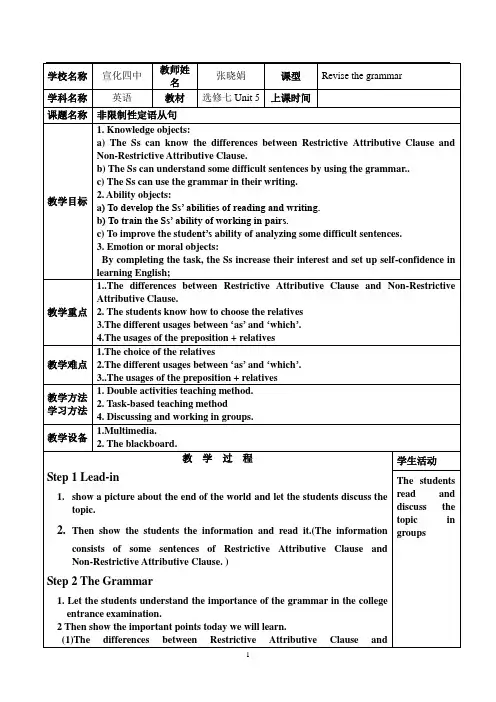
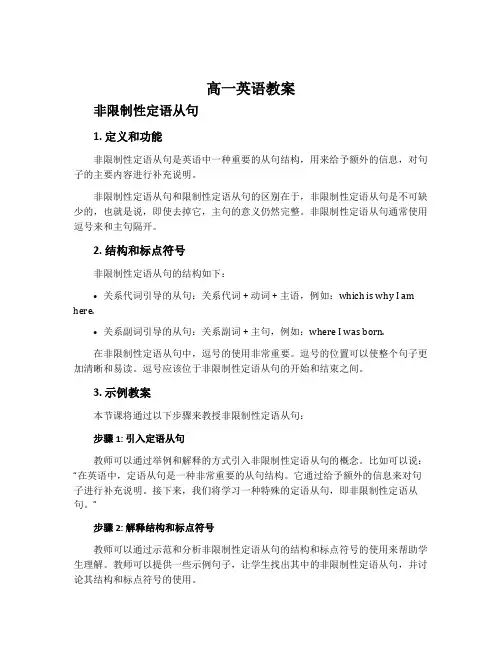
高一英语教案非限制性定语从句1. 定义和功能非限制性定语从句是英语中一种重要的从句结构,用来给予额外的信息,对句子的主要内容进行补充说明。
非限制性定语从句和限制性定语从句的区别在于,非限制性定语从句是不可缺少的,也就是说,即使去掉它,主句的意义仍然完整。
非限制性定语从句通常使用逗号来和主句隔开。
2. 结构和标点符号非限制性定语从句的结构如下:•关系代词引导的从句:关系代词 + 动词 + 主语,例如:which is why I am here.•关系副词引导的从句:关系副词 + 主句,例如:where I was born.在非限制性定语从句中,逗号的使用非常重要。
逗号的位置可以使整个句子更加清晰和易读。
逗号应该位于非限制性定语从句的开始和结束之间。
3. 示例教案本节课将通过以下步骤来教授非限制性定语从句:步骤1: 引入定语从句教师可以通过举例和解释的方式引入非限制性定语从句的概念。
比如可以说:“在英语中,定语从句是一种非常重要的从句结构。
它通过给予额外的信息来对句子进行补充说明。
接下来,我们将学习一种特殊的定语从句,即非限制性定语从句。
”步骤2: 解释结构和标点符号教师可以通过示范和分析非限制性定语从句的结构和标点符号的使用来帮助学生理解。
教师可以提供一些示例句子,让学生找出其中的非限制性定语从句,并讨论其结构和标点符号的使用。
步骤3: 练习和巩固教师可以设计一些练习来帮助学生巩固所学的知识。
例如,教师可以给学生一些句子,让他们根据上下文判断其中是否有非限制性定语从句,并标出其结构和标点符号的位置。
步骤4: 拓展练习教师可以设计一些拓展练习来挑战学生。
例如,教师可以给学生一篇短文,让他们找出其中的非限制性定语从句,并解释其结构和标点符号的使用。
4. 总结与评价通过本节课的学习,学生应该能够理解非限制性定语从句的定义、结构和标点符号的使用。
他们应该能够在阅读和写作中识别和运用非限制性定语从句,从而提高他们的英语表达能力。
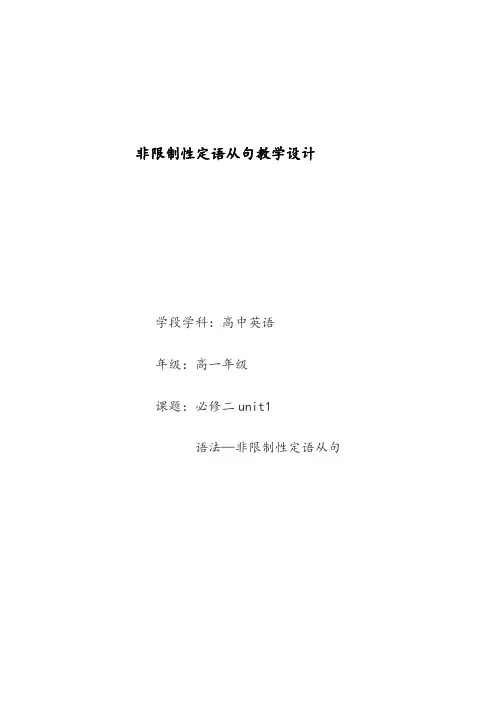
非限制性定语从句教学设计学段学科:高中英语年级:高一年级课题:必修二unit1语法—非限制性定语从句The Non-restrictive Attributive Clauses教学设计一、设计理念在当前该地区的英语课堂上,实施任务和开展活动具有很大的挑战性,需要在实际操作中对教材进行重新整合,并要根据学生的环境和接受能力来开展行之有效的任务和活动。
同时利用多媒体技术,帮助解决教学难题。
这样,既能为学生创设真实可视的英语学习环境,也能激发学生积极参与的欲望,引起学生的共鸣和兴趣。
二、知识点分析( Analysis of the knowledge point)Although students have learnt the main point of attributive clauses, they also need to grasp more tips of this clause. This lesson is aimed to encourage the Ss to to know the difference of these two clauses and strengthen the usage of the relative pronoun and to use attributive clauses correctly and properly.三、学情分析(Analysis of the students)Although High school students have the basic abilities of listening, speaking, reading and writing,most of students have the disadvantages of poor English, so during my class I must take into account the specific circumstances of students at different levels and different needs so as to make all levels of students to participate in the class .四、教学目标 (Teaching goals)1.知识目标 (knowledge goles)a. Get students to know more about attributive clauses.b. Let students learn non-restrictive attributive clauses2.能力目标(ability goals)Enable students to use attributive clauses correctly and properly.3.情感目标(emotional goals)Get students to become interested in grammar learning五、教学重难点(teaching important points and difficult points) Get students to understand and use attributive clausesEnable students to learn how to use attributive clauses correctly.六、教学过程(teaching procedures)Step 1. Greetings and introduce the main content of this class.Step2 . Observe and discuss the pairs of sentences .Analyze the structure of the two sentences and try to translate them and to conclude the difference.Step3.Summarize the characteristic of two clauses in a form and to feel the difference of the two sentences again.Step4. Discover and stress some issues that need attention about attributive clause。
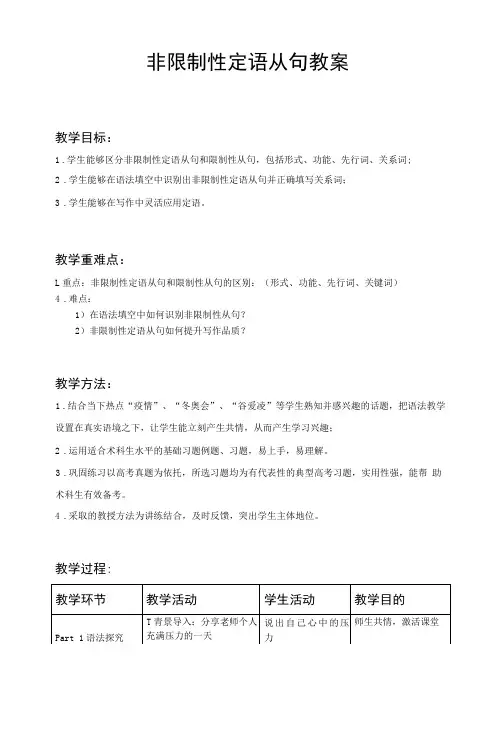
非限制性定语从句教案
教学目标:
1.学生能够区分非限制性定语从句和限制性从句,包括形式、功能、先行词、关系词;
2.学生能够在语法填空中识别出非限制性定语从句并正确填写关系词;
3.学生能够在写作中灵活应用定语。
教学重难点:
L重点:非限制性定语从句和限制性从句的区别:(形式、功能、先行词、关键词)
4.难点:
1)在语法填空中如何识别非限制性从句?
2)非限制性定语从句如何提升写作品质?
教学方法:
1.结合当下热点“疫情”、“冬奥会”、“谷爱凌”等学生熟知并感兴趣的话题,把语法教学设置在真实语境之下,让学生能立刻产生共情,从而产生学习兴趣;
2.运用适合术科生水平的基础习题例题、习题,易上手,易理解。
3.巩固练习以高考真题为依托,所选习题均为有代表性的典型高考习题,实用性强,能帮助术科生有效备考。
4.采取的教授方法为讲练结合,及时反馈,突出学生主体地位。
教学过程:。
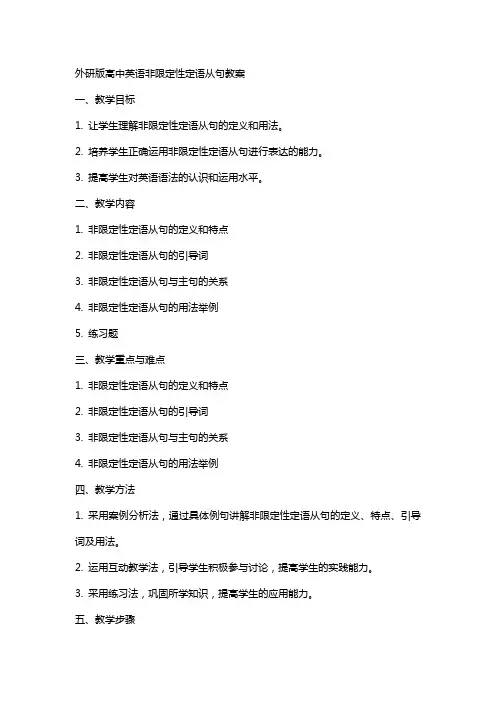
外研版高中英语非限定性定语从句教案一、教学目标1. 让学生理解非限定性定语从句的定义和用法。
2. 培养学生正确运用非限定性定语从句进行表达的能力。
3. 提高学生对英语语法的认识和运用水平。
二、教学内容1. 非限定性定语从句的定义和特点2. 非限定性定语从句的引导词3. 非限定性定语从句与主句的关系4. 非限定性定语从句的用法举例5. 练习题三、教学重点与难点1. 非限定性定语从句的定义和特点2. 非限定性定语从句的引导词3. 非限定性定语从句与主句的关系4. 非限定性定语从句的用法举例四、教学方法1. 采用案例分析法,通过具体例句讲解非限定性定语从句的定义、特点、引导词及用法。
2. 运用互动教学法,引导学生积极参与讨论,提高学生的实践能力。
3. 采用练习法,巩固所学知识,提高学生的应用能力。
五、教学步骤1. 引入非限定性定语从句的概念,让学生初步了解其定义和特点。
2. 讲解非限定性定语从句的引导词,如which、who、whom等,并举例说明。
3. 通过例句分析,让学生理解非限定性定语从句与主句的关系。
4. 结合实际语境,让学生学会正确运用非限定性定语从句进行表达。
5. 布置练习题,巩固所学知识,提高学生的应用能力。
六、教学拓展1. 引导学生了解非限定性定语从句在阅读理解中的作用,提高学生的阅读能力。
2. 分析非限定性定语从句在写作中的运用,帮助学生丰富句型结构,提高写作水平。
3. 通过实例,让学生了解非限定性定语从句在口语交流中的重要性,提高口语表达能力。
七、课堂练习1. 完成下列句子,使用非限定性定语从句:a. My friend ___ is ing to visit me next week.b. The book ___ you gave me is very interesting.c. The woman ___ is talking to my sister is her teacher.2. 判断下列句子中非限定性定语从句的使用是否正确:a. The man who is playing football is my brother.b. The cat, which is sleeping on the sofa, is very cute.c. The school, whose principal is Mr. Wang, is famous in our city.八、课后作业1. 复习本节课所学的非限定性定语从句的知识点。
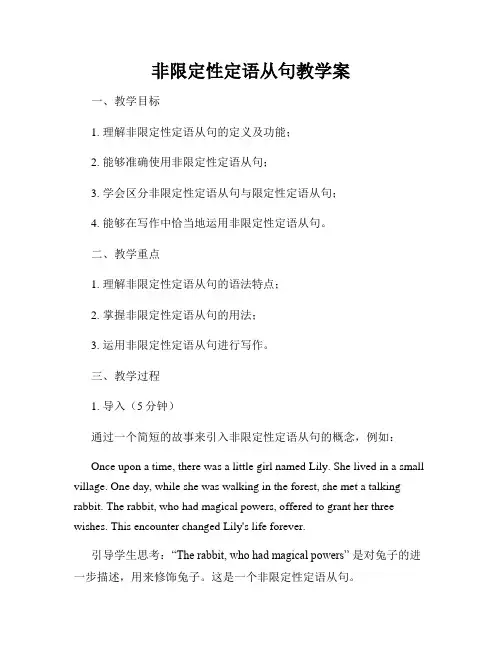
非限定性定语从句教学案一、教学目标1. 理解非限定性定语从句的定义及功能;2. 能够准确使用非限定性定语从句;3. 学会区分非限定性定语从句与限定性定语从句;4. 能够在写作中恰当地运用非限定性定语从句。
二、教学重点1. 理解非限定性定语从句的语法特点;2. 掌握非限定性定语从句的用法;3. 运用非限定性定语从句进行写作。
三、教学过程1. 导入(5分钟)通过一个简短的故事来引入非限定性定语从句的概念,例如:Once upon a time, there was a little girl named Lily. She lived in a small village. One day, while she was walking in the forest, she met a talking rabbit. The rabbit, who had magical powers, offered to grant her three wishes. This encounter changed Lily's life forever.引导学生思考:“The rabbit, who had magical powers” 是对兔子的进一步描述,用来修饰兔子。
这是一个非限定性定语从句。
2. 学习非限定性定语从句的定义和功能(10分钟)解释非限定性定语从句是用来修饰某一名词或代词的从句,但它不是这个名词或代词在句子中的主语或宾语。
非限定性定语从句通常用逗号或引号隔开,可以提供额外信息,增加句子的修饰效果。
举例说明:- My uncle, who lives in London, came to visit us last week. (非限定性定语从句修饰"uncle")- The book, written by a famous author, is very popular among teenagers. (非限定性定语从句修饰"book")解释非限定性定语从句的功能是为了进一步描述或补充名词或代词的信息,使句子更加丰富有趣。
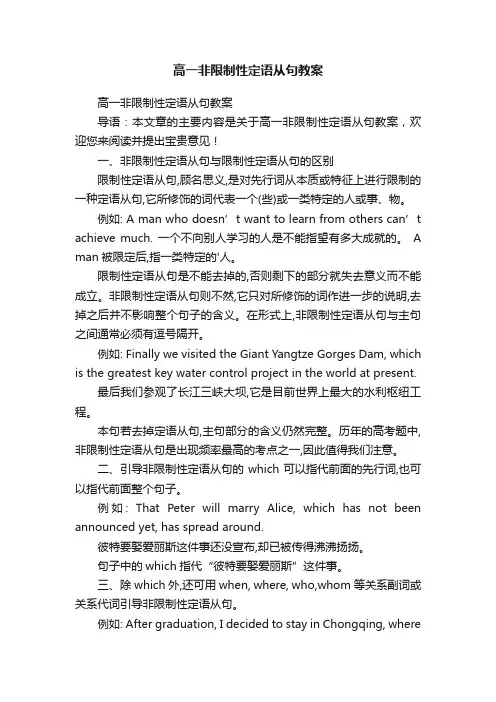
高一非限制性定语从句教案高一非限制性定语从句教案导语:本文章的主要内容是关于高一非限制性定语从句教案,欢迎您来阅读并提出宝贵意见!一、非限制性定语从句与限制性定语从句的区别限制性定语从句,顾名思义,是对先行词从本质或特征上进行限制的一种定语从句,它所修饰的词代表一个(些)或一类特定的人或事、物。
例如: A man who doesn’t want to learn from others can’t achieve much. 一个不向别人学习的人是不能指望有多大成就的。
A man被限定后,指一类特定的'人。
限制性定语从句是不能去掉的,否则剩下的部分就失去意义而不能成立。
非限制性定语从句则不然,它只对所修饰的词作进一步的说明,去掉之后并不影响整个句子的含义。
在形式上,非限制性定语从句与主句之间通常必须有逗号隔开。
例如: Finally we visited the Giant Yangtze Gorges Dam, which is the greatest key water control project in the world at present.最后我们参观了长江三峡大坝,它是目前世界上最大的水利枢纽工程。
本句若去掉定语从句,主句部分的含义仍然完整。
历年的高考题中,非限制性定语从句是出现频率最高的考点之一,因此值得我们注意。
二、引导非限制性定语从句的which可以指代前面的先行词,也可以指代前面整个句子。
例如: That Peter will marry Alice, which has not been announced yet, has spread around.彼特要娶爱丽斯这件事还没宣布,却已被传得沸沸扬扬。
句子中的which指代“彼特要娶爱丽斯”这件事。
三、除which外,还可用when, where, who,whom等关系副词或关系代词引导非限制性定语从句。
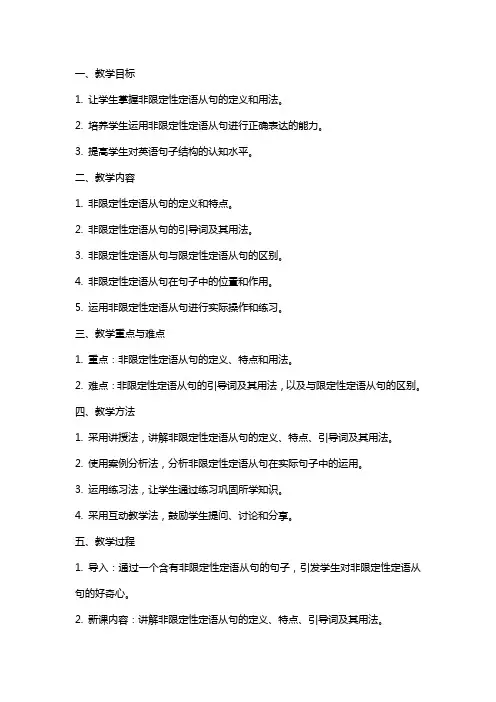
一、教学目标1. 让学生掌握非限定性定语从句的定义和用法。
2. 培养学生运用非限定性定语从句进行正确表达的能力。
3. 提高学生对英语句子结构的认知水平。
二、教学内容1. 非限定性定语从句的定义和特点。
2. 非限定性定语从句的引导词及其用法。
3. 非限定性定语从句与限定性定语从句的区别。
4. 非限定性定语从句在句子中的位置和作用。
5. 运用非限定性定语从句进行实际操作和练习。
三、教学重点与难点1. 重点:非限定性定语从句的定义、特点和用法。
2. 难点:非限定性定语从句的引导词及其用法,以及与限定性定语从句的区别。
四、教学方法1. 采用讲授法,讲解非限定性定语从句的定义、特点、引导词及其用法。
2. 使用案例分析法,分析非限定性定语从句在实际句子中的运用。
3. 运用练习法,让学生通过练习巩固所学知识。
4. 采用互动教学法,鼓励学生提问、讨论和分享。
五、教学过程1. 导入:通过一个含有非限定性定语从句的句子,引发学生对非限定性定语从句的好奇心。
2. 新课内容:讲解非限定性定语从句的定义、特点、引导词及其用法。
3. 案例分析:分析非限定性定语从句在实际句子中的运用,帮助学生理解并区分非限定性定语从句和限定性定语从句。
4. 课堂练习:设计一些练习题,让学生运用所学知识进行实际操作。
5. 互动环节:鼓励学生提问、讨论和分享,解答学生在学习过程中遇到的问题。
六、教学策略1. 运用多媒体教学手段,如PPT、视频等,增强课堂的趣味性。
2. 通过例句和练习,让学生在实际语境中感受和理解非限定性定语从句的用法。
3. 创设真实语境,让学生在交流互动中运用非限定性定语从句。
4. 针对学生的不同水平,设计多层次、多类型的练习,满足学生的学习需求。
5. 注重个体差异,给予学生个性化的指导和关爱,帮助每个学生提高。
七、教学评价1. 课堂参与度:观察学生在课堂上的发言、提问和互动情况,了解学生的学习积极性。
2. 练习完成情况:检查学生课堂练习和课后作业的完成质量,评估学生的学习效果。
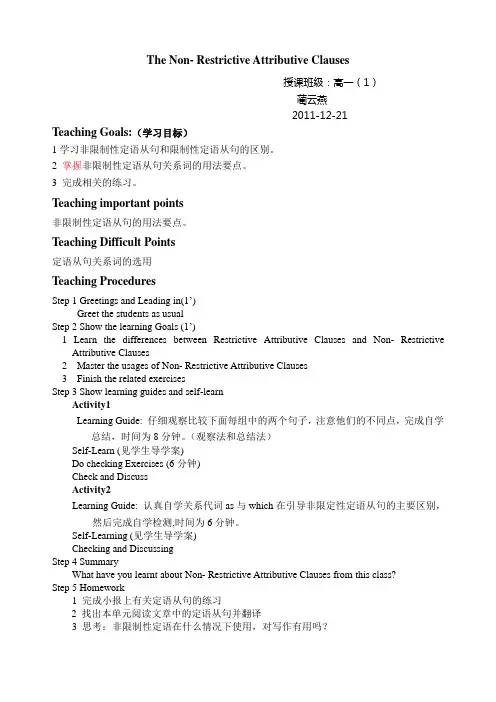
The Non- Restrictive Attributive Clauses授课班级:高一(1)蔺云燕2011-12-21Teaching Goals:(学习目标)1学习非限制性定语从句和限制性定语从句的区别。
2掌握非限制性定语从句关系词的用法要点。
3 完成相关的练习。
Teaching important points非限制性定语从句的用法要点。
Teaching Difficult Points定语从句关系词的选用Teaching ProceduresStep 1 Greetings and Leading in(1’)Greet the students as usualStep 2 Show the learning Goals (1’)1 Learn the differences between Restrictive Attributive Clauses and Non- RestrictiveAttributive Clauses2 Master the usages of Non- Restrictive Attributive Clauses3 Finish the related exercisesStep 3 Show learning guides and self-learnActivity1Learning Guide: 仔细观察比较下面每组中的两个句子,注意他们的不同点,完成自学总结,时间为8分钟。
(观察法和总结法)Self-Learn (见学生导学案)Do checking Exercises (6分钟)Check and DiscussActivity2Learning Guide: 认真自学关系代词as与which在引导非限定性定语从句的主要区别,然后完成自学检测,时间为6分钟。
Self-Learning (见学生导学案)Checking and DiscussingStep 4 SummaryWhat have you learnt about Non- Restrictive Attributive Clauses from this class?Step 5 Homework1 完成小报上有关定语从句的练习2 找出本单元阅读文章中的定语从句并翻译3 思考:非限制性定语在什么情况下使用,对写作有用吗?。
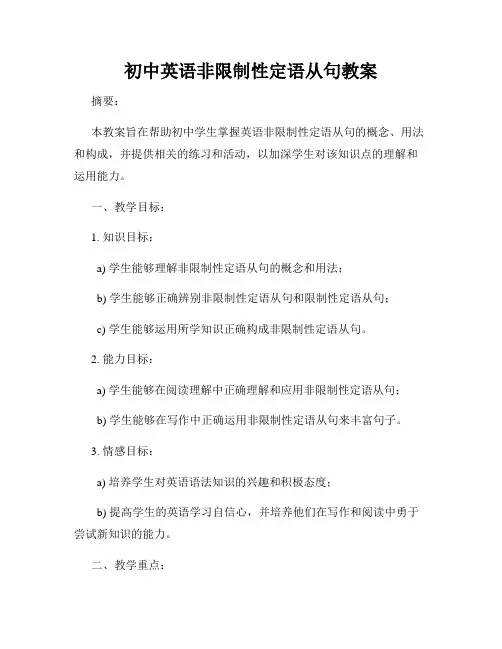
初中英语非限制性定语从句教案摘要:本教案旨在帮助初中学生掌握英语非限制性定语从句的概念、用法和构成,并提供相关的练习和活动,以加深学生对该知识点的理解和运用能力。
一、教学目标:1. 知识目标:a) 学生能够理解非限制性定语从句的概念和用法;b) 学生能够正确辨别非限制性定语从句和限制性定语从句;c) 学生能够运用所学知识正确构成非限制性定语从句。
2. 能力目标:a) 学生能够在阅读理解中正确理解和应用非限制性定语从句;b) 学生能够在写作中正确运用非限制性定语从句来丰富句子。
3. 情感目标:a) 培养学生对英语语法知识的兴趣和积极态度;b) 提高学生的英语学习自信心,并培养他们在写作和阅读中勇于尝试新知识的能力。
二、教学重点:1. 理解非限制性定语从句的概念和用法;2. 能够正确辨别和构成非限制性定语从句。
三、教学内容及安排:1. 导入(5分钟)a) 通过教师提问和学生回答的方式,复习限制性定语从句的概念和用法。
2. 概念讲解(10分钟)a) 教师给出非限制性定语从句的定义,并与限制性定语从句进行对比说明;b) 教师给出非限制性定语从句的句子结构和标点要求,并解释其具体用法。
3. 语法讲解(10分钟)a) 教师通过例句和语法规则的讲解,深入解析非限制性定语从句的构成和使用方法;b) 教师重点讲解非限制性定语从句与主句之间的关系,以及修饰对象的不同形式。
4. 练习与活动(20分钟)a) 学生进行非限制性定语从句的判断练习,区分限制性定语从句和非限制性定语从句;b) 学生通过阅读材料,找出其中的非限制性定语从句,并分析其作用;c) 学生进行小组活动,编写句子并运用非限制性定语从句,以实际运用巩固所学知识。
5. 拓展练习(10分钟)a) 学生配对练习,互相出题并回答关于非限制性定语从句的问题;b) 学生进行语法填空练习,使用非限制性定语从句来完善句子。
6. 总结与反思(5分钟)a) 教师帮助学生总结非限制性定语从句的特点和用法;b) 学生针对所学内容,进行自我反思并提出疑问。
非限制性定语从句非限制性定语从句语境呈现1观察下列句子,注意划线部分的用法。
1)This note was left by Mr.Li,who was here a moment ago.2)This novel,which I have read three times,is very touching.3)The bus ran into a crowd of people,some of whom were sent to hospital.4China has hundreds of islands,the largest of which is Taiwan.5)She was kinder to her youngest son than to the others,which,of course,made the others envy him.6)All of my books are on the desk,where I always keep them.7)My brother,whose skin is a little black,has a slim figure.8)They decided to put off the meeting until next Saturday,when they wouldn’t be so busy.规律精点1 所谓非限制性定语从句,顾名思义,对主句所描述的人或物起的作用,去掉后主句意思仍然完整;它与句子之间常用逗号隔开,其引导词有who,whom,whose,which,when,where,as。
that和why 不能引导分限制性定语从句。
有时用不定代词、数词或形容词最高级+of+whom/which指代先行词或先行词的一部分。
语境呈现2观察下列句子,注意划线部分的用法。
1)As is known to us,the sky is blue.The sky is blue,which is known to us.2)The big tree was cut down yesterday,as is reported in today’s newspaper.The big tree was cut down yesterday,which is about three hundred years old.规律精点2 关系代词as引导非限制性定语从句,其与which的区别在于:1)as引导的非限制性定语从句可置于句首、居中或句尾;which引导的非限制性定语从句只能置于。
人教版选修七Unit 5Period 3 Grammar语言知识目标:复习非限制性定语从句的特点和关系词语言能力目标:能够写出含有非限制性定语从句的句子,并在书面表达中进行运用1教学重点:掌握非限制性定语从句的特点,关系代词和关系副词使用的场合;能够运2教学难点:关系代词和关系副词使用的场合;在写作中运用非限制性定语从句;明确限制性定语从句与非限制性定语从句的区别。
教学准备1.学生的学习准备:复习非限制性定语从句的特点及关系词。
2教师的教学准备:整理关系代词和关系副词的使用场合,并设计合理的场景。
3.教学用具的设计和准备:制作多媒体课件Step 1 Presentation1. Enjoy a beautiful composition which comes from the 2021 Zhejiang college entranceexamination.I prefer my English classes to be taught in both English and Chinese, whose advantage is that it is easy for us to understand what the teacher talks about. The teacher first teaches the class in English, and then she explains those that are hard to understand to us so that we get a better understanding of the passage. That will be good for us。
However teaching the class in two languages will make the English atmospherenot so strong。
教师姓名WilliamQ 学生姓名教材版本学科名称英语年级上课时间课题名称非限制性定语从句教学目标讲清非限制性定语从句与限制性定居从句之间的区别,解题时的易错之处教学重点非限制性定语从句教学过程备注Step 1 Warming-up1.Free talkDo some talking to know about the English level of the student.Step 2 例题:1. The thing ________________ he is talking is of great importance.A. about whichB. thatC. about thatD. which2. ---Does the teacher know everybody ___________ planted the trees?---Y es, he does.A. whichB. whoseC. whereD. who3. ---Who is the man ___________ was talking to our English teacher?---Oh! It’s Mr Baker, our maths teacher.A. heB. thatC. whomD. which4. I hate the people ________ don’t help others when they are in trouble.A. whoB. whichC. theyD. where5. Mr. White, ___________ car had been stolen, came to the policeman.A. whoB. thatC. whoseD. which6. He got to the village _______ his family once lived before liberation.A. thatB. whichC. whenD. where7. This is the house _______ I want to buy.A. in whichB. thatC. whoseD. where8. This is the house _______ our beloved Premier Zhou once lived and worked.A. whichB. thatC. whenD. where9. He didn’t tell me the place _______ he was born.A. thatB. whichC. whenD. where10. He lived in a small village, ______ was a long way from the railway station.A. thatB. whichC. whereD. when11.______ is well known to everybody, Taiwan is an inseparable part of China.A. AsB. WhichC. ThatD. WhereStep 3 知识点:一】非限制性定语从句:1)①非限定性定语从句起补充说明作用,缺少也不会影响全句的理解。
一、教学目标1. 让学生掌握非限定性定语从句的定义和基本用法。
2. 培养学生正确运用非限定性定语从句表达思想的能力。
3. 提高学生对英语语法的认识和运用能力。
二、教学内容1. 非限定性定语从句的定义和特点。
2. 非限定性定语从句的引导词及其用法。
3. 非限定性定语从句与限定性定语从句的区别。
4. 非限定性定语从句在句子中的位置和作用。
5. 非限定性定语从句的翻译方法和技巧。
三、教学重点与难点1. 重点:非限定性定语从句的定义、引导词及其用法。
2. 难点:非限定性定语从句在句子中的位置和作用,以及与限定性定语从句的区别。
四、教学方法1. 采用案例分析法,通过大量例句让学生直观地理解非限定性定语从句的用法。
2. 运用对比分析法,让学生明确非限定性定语从句与限定性定语从句的区别。
3. 采用任务型教学法,让学生在实践中运用非限定性定语从句进行语言表达。
五、教学过程1. 导入:通过一个谜语引出非限定性定语从句的概念。
2. 讲解:讲解非限定性定语从句的定义、特点、引导词及其用法。
3. 示例:分析一些含有非限定性定语从句的例句,让学生理解其在句子中的作用。
4. 练习:让学生分组练习,用非限定性定语从句改写一些句子。
5. 总结:概括本节课的主要内容,强调非限定性定语从句的用法和位置。
6. 作业:布置一些有关非限定性定语从句的练习题,让学生巩固所学知识。
六、教学拓展1. 引导学生了解非限定性定语从句在英语写作中的作用,如增强句子表达能力、使句子更灵活等。
2. 介绍一些常见的非限定性定语从句的错误类型,并引导学生学会避免这些错误。
七、课堂互动1. 采用小组讨论的方式,让学生共同探讨非限定性定语从句的用法。
2. 设计一些填空题、改错题等,让学生在互动中巩固所学知识。
八、教学评价1. 课后收集学生的作业,检查他们对非限定性定语从句的掌握情况。
2. 在下一节课开始时,进行一个小测验,测试学生对非限定性定语从句的掌握程度。
非限制性定语从句一、定语从句的概念在复合句中,修饰某一名词或代词的从句叫定语从句。
被修饰的名词或代词叫先行词,定语从句一般放在先行词的后面。
二、定语从句的关系词引导定语从句的关系词有关系代词和关系副词,常见的关系代词包括that,which,who(宾格whom,所有格whose)等,关系副词包括where,when,why等。
关系代词和关系副词放在先行词及定语从句之间起连接作用,同时又作定语从句的重要成分。
三、定语从句的分类根据定语从句与先行词的关系,定语从句可分为限制性定语从句及非限制性定语从句。
限制性定语从句紧跟先行词,主句与从句不用逗号分开,从句不可省去,非限制性定语从句主句与从句之间有逗号分开,起补充说明作用,如省去,意思仍完整。
四、关系代词的用法1. that 既可以用于指人,也可以用于指物。
在从句中作主语或宾语,作主语时不可省略,作宾语可省略。
例如:Mary likes music that is quiet and gentle.玛丽喜欢轻柔的音乐。
(that作主语)The coat (that)I put on the desk is blue.我放在桌子上的那件外套是蓝色的。
(that作宾语)2.which用于指物,在句中作主语或宾语,作主语不可省略,作宾语可省略。
例如:The building which stands near the train station is a supermarket.位于火车站附近的那座大楼是一家超市。
(作主语)The film (which)we saw last night was wonderful. 我们昨天晚上看的那部电影很好看。
(作宾语)3.who,whom用于指人,who 用作主语,whom用作宾语。
在口语中,有时可用who代替whom,也可省略。
例如:The girl who often helps me with my English is from England.经常在英语方面帮助我的那个女孩是英国人。
非限制性定语从句学案一、课前准备1.定语从句有两种基本形式:_______________和_______________;1).什么是限制性定语从句?限制性定语从句,是对先行词从本质或特征上进行限制的一种定语从句,它所修饰的词代表一个(些)或一类特定的人或事、物。
2).什么是非限制性定语从句?非限制性定语从句,它只对所修饰的词作进一步的说明,去掉之后并不影响句子的整个含义。
在形式上,非限制性定语从句与主句之间通常用逗号隔开。
2.辨别下列句子,哪句是限制性定语从句,哪句是非限制性定语从句?1).Finally we visited to the Giant Yangtze Gorges Dam, which is the greatest key water control pro ject in the world at present.2).A man who doesn't learn from others can't achieve much.3. 从本单元<KEEP IT UP, XIE LEI>文章中找出含非限制性定语从句的句子。
二、课堂互动1.思考下列问题。
1)Heat is another form of energy, which is as important as other kinds of energy.(which可以用that替换吗?)2)That Peter will marry Alice, which has not been announced yet, has spread around.(这句的which指的是什么?)(用合适的引导词填空,完成句子3,4,5,6,7,8)3)Miss Howe, _______ you met in the library, is our new teacher.4) The Arabs, ______ are famous for their horses and camels, use these animals for work and insports.5) Li Ming, ________ mother has been ill for two days, is absent from school today.6) He lives in the city, _______ there is a high tower.7) The People’s Republic of China was founded in 1949, _______ he was born.8) Wu Dong, ______________I went to see the film, enjoyed it very much.9) He was eager to go to the hospital to see his stepmother, whom he loved and respected as hisown mother. (此句中的whom可以省略吗?)10) Have you got the postcard which I sent you? (此句中的which可以省略吗?)(用合适的引导词填空,完成句子11,12,13)11) He wrote a book, the name of ________ I’ve completely forgotten.12) It’s a family of eight people, all of _______ love music.13) There are fifty students in the class, sixty percent of _______are boys.小结: 1) that 不会用于____________;2) which除了可以指代前面的先行词,还可以指代___________.3) 用于非限制性定语从句中的引导词有哪些?4)在限制性定语从句中作宾语时,引导词可以________,但引导非限制性定语从句的关联词________。
非限制性定语从句非限制性定语从句语境呈现1观察下列句子,注意划线部分的用法。
1)This note was left by Mr.Li,who was here a moment ago.2)This novel,which I have read three times,is very touching.3)The bus ran into a crowd of people,some of whom were sent to hospital.4China has hundreds of islands,the largest of which is Taiwan.5)She was kinder to her youngest son than to the others,which,of course,made the others envy him.6)All of my books are on the desk,where I always keep them.7)My brother,whose skin is a little black,has a slim figure.8)They decided to put off the meeting until next Saturday,when they wouldn’t be so busy.规律精点1 所谓非限制性定语从句,顾名思义,对主句所描述的人或物起的作用,去掉后主句意思仍然完整;它与句子之间常用逗号隔开,其引导词有who,whom,whose,which,when,where,as。
that和why 不能引导分限制性定语从句。
有时用不定代词、数词或形容词最高级+of+whom/which指代先行词或先行词的一部分。
语境呈现2观察下列句子,注意划线部分的用法。
1)As is known to us,the sky is blue.The sky is blue,which is known to us.2)The big tree was cut down yesterday,as is reported in today’s newspaper.The big tree was cut down yesterday,which is about three hundred years old.规律精点2 关系代词as引导非限制性定语从句,其与which的区别在于:1)as引导的非限制性定语从句可置于句首、居中或句尾;which引导的非限制性定语从句只能置于。
(如果定语从句为否定句或表示否定意义,则使用which)。
2)as指代的是,which除了可指代整个主句内容外还可指代主句的某个部分。
1.The result of the experiment was very good, we hadn’t expected.A.whenB.whatC.thatD.which2.Lily was always talking about her wealthy husband, of course,made the other ladies unhappy.A.whoB.whichC.whatD.that3)The writer has written a number of books, only one is widely read.A.whichB.of whichC.thatD.what4)This is Mr Day, I think has something interesting to tell you.A.whoB.whomC.thatD.which5) is reported in today’s paper,people have found the lost boy.A.ItB.ThatC.AsD.What6)The result was not the same they had expected, was rather disappointing.A.which;asB.as;whichC.as;thatD.that;which高考链接1)After the flooding,people were suffering in that area, urgently needed clean water,medicine and shelter to survive.A.whichB.whoC.whereD.what2)When deeply absorbed in work, he often was,he would forget all about eating or sleeping.A.thatB.whichC.whereD.when浅谈非限制性定语从句定语从句(限制性和非限制性定语从句的区别)1.定语从句有时跟先行词的关系并不十分密切,只是作一些补充说明,不起限制作用,这种从句称为非限制性定语从句。
它常常用逗号与主句分开;翻译时常译成并列的分句。
例如:This note was left by John,who was here a moment ago.这条子是约翰留下的,他刚才来过这儿。
2.非限制性定语从句在修饰人时用who(主格),whom(宾格),whose(所有格),即:在定语从句中关系代词指人做主语时,只能用who;作宾语时,只能用whom,不能有几种选择,也不能省略,只有一种答案。
在修饰物时用which而不能用that。
总之,非限制性定语从句里没有that,也没有why。
1)Mr.Zhang,who came to see me yesterday,is an old friend of my father’s.张先生昨天来看我,他是我父亲的一位老朋友。
2)She had seven children,three of whom lived to grow up.她生了七个孩子,其中三个长大成人。
3)The team is headed by a Chinese,whose wife is a Japanese.这个对的队长是个中国人,他的妻子是日本人。
4)We visited the Jade Buddha Temple,which is in the northwestern part of Shanghai. 我们参观了玉佛寺,它在上海的西北部。
5.It now has 20,000 hectares of land,more than two-thirds of which are ploughed.它有两万公顷的土地,其中三分之二以上已经耕种。
6)We walked down the village street,where they were having market day.我们沿着村庄的街道走,他们的赶集日在哪儿进行。
7)In the old days, I was a little boy,the city had no industry to speak of.过去这城市无工业可言,那时我还是个小孩。
3.引导非限制性定语从句,若关系代词所指代的先行项是整个主句,则关系代词用as或which.它们有三点相同和四点不同之处。
相同点:1)which和as都可在SVC(主语+系动词+表语)或SV(主语+谓语)结构的非限制性定语从句中作主语,此时两者可互换使用。
He said he had lost the book,which/as was true.All the schools will reopen on Sept.1(st),which/as is announced in today’s paper.2)在SVC结构的非限制性定语从句中,which和as作表语时可互换使用。
注意此时的which或as指代上文中的表语部分。
He seemed a foreigner,which /as in fact he was.3)在SVO(主谓宾)结构的非限制性定语从句中,which和as作宾语时可互换。
I was very useful to him,which/as he realized.不同点:1) 在SVOCo(主谓宾宾补)结构的非限制性定语从句中,做主语或宾语时通常用which,而不用as.It was raining hard,which kept us indoors.2) 在SVO结构的非限制性定语从句中,做主语时通常用which,而不用as. Tom has made great progress,which delighted us.3) as引导非限制性定语从句时,通常用在表示肯定意义的从句中,而不能用在表示否定意义的从句中;which则不受此限制。
例如:She has been married again,which was unexpected.(which常在定语从句中作delay耽搁,推迟、worry、upset、make的主语,且定语从句中常含复合结构)4) as所引导的非限制性定语从句位置比较灵活,它可以位于句末,也可位于句首或居中;而which所引导的非限制性定语从句位置比较固定,通常位于句末,而不可移置句首。
例如:We can’t do without rules,as/which you know. As you know,we can’t do without rules.He failed the exam,which/as was natural. As was natural,he failed the exam.All the schools will reopen on Sept.1(st),which/as is announced in today’s paper.As is announced in today’s paper,all the schools will reopen on Sept.1(st).He admires Mr.Brown very much,which surprises me.He arrived half an hour late,which annoyed us all.My sister is a good nurse,which I am not.His sister has become a doctor,which he wants her to be.易混辨析巧学助记:巧辩限制性与非限制性定语从句定语从句好分辨,没有逗号即为“限”,逗号一出定“非限”;关系引导所用词,随着“先行”巧妙变;“非限”that/why靠边站;“非限”引导不省全(全部不可省略);“as”殊词记心间;the same/such…as…连,“正如、正像”意恒念,固定搭配多锻炼。